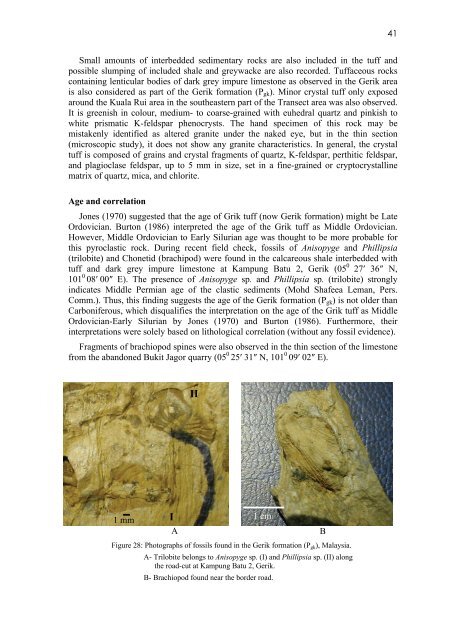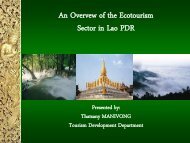GEOLOGY OF THE PENGKALAN HULU-BETONG TRANSECT ...
GEOLOGY OF THE PENGKALAN HULU-BETONG TRANSECT ...
GEOLOGY OF THE PENGKALAN HULU-BETONG TRANSECT ...
Create successful ePaper yourself
Turn your PDF publications into a flip-book with our unique Google optimized e-Paper software.
Small amounts of interbedded sedimentary rocks are also included in the tuff and<br />
possible slumping of included shale and greywacke are also recorded. Tuffaceous rocks<br />
containing lenticular bodies of dark grey impure limestone as observed in the Gerik area<br />
is also considered as part of the Gerik formation (Pgk). Minor crystal tuff only exposed<br />
around the Kuala Rui area in the southeastern part of the Transect area was also observed.<br />
It is greenish in colour, medium- to coarse-grained with euhedral quartz and pinkish to<br />
white prismatic K-feldspar phenocrysts. The hand specimen of this rock may be<br />
mistakenly identified as altered granite under the naked eye, but in the thin section<br />
(microscopic study), it does not show any granite characteristics. In general, the crystal<br />
tuff is composed of grains and crystal fragments of quartz, K-feldspar, perthitic feldspar,<br />
and plagioclase feldspar, up to 5 mm in size, set in a fine-grained or cryptocrystalline<br />
matrix of quartz, mica, and chlorite.<br />
Age and correlation<br />
Jones (1970) suggested that the age of Grik tuff (now Gerik formation) might be Late<br />
Ordovician. Burton (1986) interpreted the age of the Grik tuff as Middle Ordovician.<br />
However, Middle Ordovician to Early Silurian age was thought to be more probable for<br />
this pyroclastic rock. During recent field check, fossils of Anisopyge and Phillipsia<br />
(trilobite) and Chonetid (brachipod) were found in the calcareous shale interbedded with<br />
tuff and dark grey impure limestone at Kampung Batu 2, Gerik (05 0 27′ 36″ N,<br />
101 0 08′ 00″ E). The presence of Anisopyge sp. and Phillipsia sp. (trilobite) strongly<br />
indicates Middle Permian age of the clastic sediments (Mohd Shafeea Leman, Pers.<br />
Comm.). Thus, this finding suggests the age of the Gerik formation (Pgk) is not older than<br />
Carboniferous, which disqualifies the interpretation on the age of the Grik tuff as Middle<br />
Ordovician-Early Silurian by Jones (1970) and Burton (1986). Furthermore, their<br />
interpretations were solely based on lithological correlation (without any fossil evidence).<br />
Fragments of brachiopod spines were also observed in the thin section of the limestone<br />
from the abandoned Bukit Jagor quarry (05 0 25′ 31″ N, 101 0 09′ 02″ E).<br />
1mm<br />
I<br />
A<br />
II<br />
1cm<br />
Figure 28: Photographs of fossils found in the Gerik formation (Pgk), Malaysia.<br />
A- Trilobite belongs to Anisopyge sp. (I) and Phillipsia sp. (II) along<br />
the road-cut at Kampung Batu 2, Gerik.<br />
B- Brachiopod found near the border road.<br />
B<br />
41



